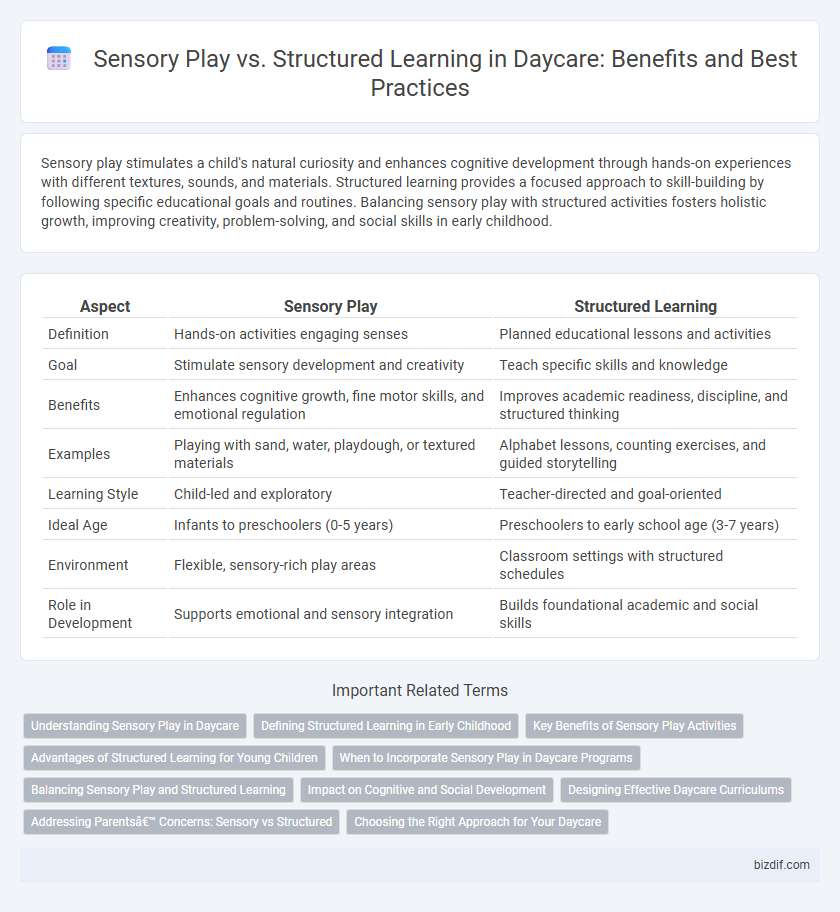Sensory play stimulates a child's natural curiosity and enhances cognitive development through hands-on experiences with different textures, sounds, and materials. Structured learning provides a focused approach to skill-building by following specific educational goals and routines. Balancing sensory play with structured activities fosters holistic growth, improving creativity, problem-solving, and social skills in early childhood.
Table of Comparison
| Aspect | Sensory Play | Structured Learning |
|---|---|---|
| Definition | Hands-on activities engaging senses | Planned educational lessons and activities |
| Goal | Stimulate sensory development and creativity | Teach specific skills and knowledge |
| Benefits | Enhances cognitive growth, fine motor skills, and emotional regulation | Improves academic readiness, discipline, and structured thinking |
| Examples | Playing with sand, water, playdough, or textured materials | Alphabet lessons, counting exercises, and guided storytelling |
| Learning Style | Child-led and exploratory | Teacher-directed and goal-oriented |
| Ideal Age | Infants to preschoolers (0-5 years) | Preschoolers to early school age (3-7 years) |
| Environment | Flexible, sensory-rich play areas | Classroom settings with structured schedules |
| Role in Development | Supports emotional and sensory integration | Builds foundational academic and social skills |
Understanding Sensory Play in Daycare
Sensory play in daycare centers enhances children's cognitive development by stimulating their tactile, auditory, and visual senses through hands-on activities such as sand, water, and playdough exploration. This type of play supports fine motor skills and creativity, promoting neural connections essential for early brain growth. Unlike structured learning, sensory play allows for open-ended experiences that encourage curiosity and self-directed discovery, fostering emotional regulation and problem-solving abilities.
Defining Structured Learning in Early Childhood
Structured learning in early childhood refers to carefully planned and guided activities designed to promote cognitive, social, and developmental skills within a consistent routine. It involves adult-led tasks such as counting exercises, letter recognition, and problem-solving games that support targeted skill acquisition. This approach contrasts with sensory play by emphasizing specific learning objectives and measurable outcomes in a daycare setting.
Key Benefits of Sensory Play Activities
Sensory play activities in daycare stimulate children's five senses, promoting cognitive growth and fine motor skills through hands-on exploration. These activities enhance language development, social interaction, and emotional regulation by engaging children in creative, self-directed experiences. Sensory play supports brain development by forming neural connections critical for problem-solving and adaptive learning in early childhood.
Advantages of Structured Learning for Young Children
Structured learning in daycare provides young children with a clear routine that enhances cognitive development and promotes a sense of security. This approach supports skill acquisition in areas such as literacy, numeracy, and social interaction through targeted activities designed to meet developmental milestones. Consistent, teacher-led instruction fosters discipline, attention span, and goal-oriented behavior essential for future academic success.
When to Incorporate Sensory Play in Daycare Programs
Incorporating sensory play in daycare programs is most effective during the early childhood years, specifically between ages 1 to 3, when toddlers benefit from hands-on exploration to develop cognitive and motor skills. Sensory activities such as tactile, auditory, and visual experiences boost neural connections and support language development alongside structured learning tasks. Balancing sensory play with targeted educational goals ensures children improve problem-solving abilities and adapt to classroom routines.
Balancing Sensory Play and Structured Learning
Balancing sensory play and structured learning in daycare settings enhances cognitive and motor development by integrating hands-on exploration with intentional skill-building activities. Sensory play stimulates neural pathways through tactile, auditory, and visual experiences, while structured learning introduces foundational concepts like numbers, letters, and social skills in a guided environment. Combining these approaches supports holistic growth, fostering creativity alongside critical thinking essential for early childhood education.
Impact on Cognitive and Social Development
Sensory play fosters cognitive development by enhancing neural connections through hands-on exploration, promoting problem-solving and creativity in daycare children. Structured learning supports social development by teaching rules, cooperation, and communication skills, essential for group interactions. A balanced combination of sensory play and structured learning maximizes both cognitive growth and social competence in early childhood development.
Designing Effective Daycare Curriculums
Effective daycare curriculums balance sensory play, which enhances cognitive development and fine motor skills through hands-on experiences, with structured learning that builds foundational literacy and numeracy. Prioritizing sensory activities like texture exploration and auditory stimulation fosters creativity and neural connections, while structured lessons ensure consistent skill acquisition and routine. Integrating both approaches tailors developmental milestones to individual needs, promoting holistic growth in early childhood education.
Addressing Parents’ Concerns: Sensory vs Structured
Sensory play enhances cognitive development by stimulating children's senses through tactile, auditory, and visual experiences, promoting creativity and problem-solving skills. Structured learning emphasizes goal-oriented activities with defined outcomes, supporting early literacy and numeracy through guided instruction. Balancing sensory play with structured learning addresses parents' concerns by fostering both exploratory learning and foundational academic skills essential for holistic development.
Choosing the Right Approach for Your Daycare
Sensory play enhances cognitive development by engaging children's senses through hands-on activities, fostering creativity and fine motor skills in a natural, exploratory environment. Structured learning provides a systematic framework that supports early literacy, numeracy, and social skills through planned, goal-oriented tasks. Selecting the right approach for your daycare depends on balancing child-led sensory experiences with guided instruction to meet developmental milestones effectively.
Sensory play vs Structured learning Infographic

 bizdif.com
bizdif.com